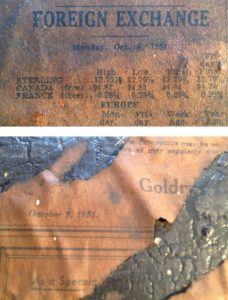Ownership History
Carolyn and Earle Brown, purchased 1953
Purchased by an anonymous donor as a promised gift to the San Francisco Museum of Modern Art, 1996
Exhibition History
Rauschenberg: Paintings and Sculpture; Cy Twombly, Paintings and Drawings, Stable Gallery, New York, September 15–October 3, 1953.
Rauschenberg: The White and Black Paintings 1949–1952, Larry Gagosian Gallery, New York, April 18–May 31, 1986.
Robert Rauschenberg: The Early 1950s, Corcoran Gallery of Art, Washington, D.C., June 15–August 11, 1991. Traveled to: The Menil Collection, Houston, September 27, 1991–January 5, 1992; Museum of Contemporary Art, Chicago, February 8–April 19, 1992; San Francisco Museum of Modern Art, May 14–August 16, 1992; Guggenheim Museum SoHo, New York, October 24, 1992–January 24, 1993.
Robert Rauschenberg, San Francisco Museum of Modern Art, May 7–September 7, 1999.
The Campaign for Art: Modern and Contemporary, San Francisco Museum of Modern Art, May 14–September 18, 2016.
This listing has been updated since the launch of the Rauschenberg Research Project and is complete as of August 31, 2016.
Publication History
Walter Hopps, ed., Robert Rauschenberg (Washington, D.C.: National Collection of Fine Arts, Smithsonian Institution, 1976), 78 (ill.).
Calvin Tomkins, The Bride and the Bachelors: Five Masters of the Avant-Garde (New York: Penguin, 1976), 209.
Rauschenberg: The White and Black Paintings 1949–1952 (New York: Larry Gagosian Gallery, 1986), n.p. (ill.).
Walter Hopps, Robert Rauschenberg: The Early 1950s (Houston: Menil Foundation and Houston Fine Art Press, 1991), 100, 153, 176, 177 (ill.).
Yve-Alain Bois and Rosalind Krauss, L’informe: Mode d’emploi (Paris: Éditions du Centre Pompidou, 1996), 56 (ill.), 247.
Walter Hopps and Susan Davidson, eds., Robert Rauschenberg: A Retrospective (New York: Solomon R. Guggenheim Museum, 1997), 23, 44, 78 (ill.), 209.
Robert Saltonstall Mattison, Robert Rauschenberg: Breaking Boundaries (New Haven, CT: Yale University Press, 2003), 54, 55 (ill.).
Stephanie Rosenthal, Black Paintings (Munich: Haus der Kunst, 2006), 127 (ill.).
Germano Celant, Alberto Burri (New York: Mitchell-Innes & Nash, 2007), 12 (ill.).
This listing has been reviewed and is complete as of August 31, 2016.








